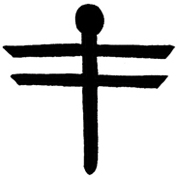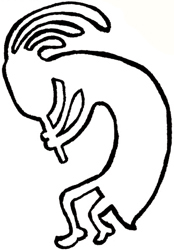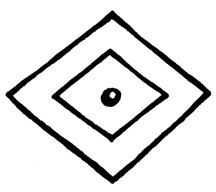

This word derives from ka (respect) and china (spirit). The kachina is a powerful example of how, for Native Americans, the world of human beings, the world of nature, and the world of spirit are all intertwined. Grasping this concept is essential to any true understanding of the Native American psyche. The concept of the kachina belongs in particular to the Pueblo people.
Frank Waters, in his 1963 publication The Book of the Hopi, tells us:
“The kachinas, then, are the inner forms, the spiritual components of the outer physical forms of life, which may be invoked to manifest their benign powers so that man may be enabled to continue his never-ending journey. They are invisible forces of life—not gods, but rather intermediaries, messengers. Hence their chief function is to bring rain, insuring the abundance of crops and the continuation of life.”
The number of kachinas has even been counted, with as many as 400 in the Hopi culture. They can be spirits of animals, of the dead, or of plants, stars, minerals, or any other natural force. In short, everything in the universe carries within it a spark of divine life which must be respected. Kachinas are also named: Tawa, for example, is the kachina of the sun, while Kokopelli, a dancing figure with a wild shock of hair and a flute, is the spirit of fertility, creativity, and music.
Kachinas can be represented by costumes and masks, and the person wearing that costume or mask is deemed to have taken on the mantle of the kachina, not only in material appearance but in spirit, too. This is a very serious responsibility, and the person behind the mask has to ensure perfect behavior as a matter of utmost respect, not only to the kachina itself, but to his people as a whole.
The Kalispel people originally lived in what is now the northern part of Idaho, northwest Montana, northeast Washington, and the southern part of British Columbia. A part of the Salishan language family, the name Kalispel means camas in a dialect of that language, and reflects the popularity of this food source for the tribe. The tribe have another name, Pend d’Oreille, which means, in French, earrings. This name was given to them by the French explorers, and refers to the shell earrings that they wore.
The Lewis and Clark Expedition made contact with the Kalispel in 1805. At the time, the tribe relied on the fish that they caught along the many tributaries of the Columbia River, as well as hunting small mammals and harvesting the camas that gave them their name. They lived in pithouses, a conical framework of timbers or poles, filled in with brush and earth, set around the edge of a circular hollow dug into the ground.
Lewis and Clark’s visit was for the purposes of establishing trade relations, and soon fur trappers set up trading posts on their territory. The Kalispel were happy to trade their furs, and a Jesuit priest, Father Pierre-Jean de Smet, founded a mission for the tribe in the 1840s. Relationships were amicable.
In common with other Native American peoples, the Kalispel signed over some of their lands and in 1855 some of the tribe relocated to reservations in Washington and at the Flathead Reservation in Montana. In 1872 more Kalispel were assigned to the Flathead Reservation, but their leader, named Charlot, led a quiet campaign of resistance, by means of excuses and various other delaying tactics. The white leaders simply put Charlot’s rival for chiefdom, a native named Arly, in charge. Arly took a party of 70 Kalispel to the Flathead Reservation, but most of the tribe—numbering several hundred people—stayed loyal to Kalispel. Charlot continued to avoid moving until he and his people were forced to do so in 1890.

The last chief of the Pennacook tribe, who lived in what is now New England. During the Wampanoag war against the English colonists in 1675, which was led by the Native American King Philip, Kancamagus decided not to fight, but to keep on friendly and peaceable terms with the colonists. However his cousin, Paugus, was of the opposite opinion. Their grandfather Passaconaway had been the first Pennacook chief to establish trade with the white men. However, an act of treachery on behalf of the English changed Kancamagus’ opinion. The English invited those tribes that were well-disposed toward them to a sports event; this was a trick, and when they arrived the Natives were attacked, some of them murdered, others sold as slaves. Kancamagus never forgot this hostility and managed to extract his revenge some years later when, in 1689, he set a trap of his own. Persuading a Pennacook woman to get the colonists to leave the gates of their settlement at Dover, New Hampshire, open one evening, the tribe attacked the dwellers inside the stockade and killed many of them. Matters escalated. The English then got the Mohawk to attack the Pennacook on their behalf; many Pennacook settlements and villages were razed to the ground. Subsequently, Kancamagus had his followers build a wall of logs by Lake Winnisquam; from behind this shield they managed to repel their Mohawk assailants before Kancamagus led his people all the way to Quebec, where the remaining Pennacook took refuge with their Abenaki allies.
The Inuit construct pithouses, about 5 feet underground, with a roof made of a framework of whalebone or arched timbers covered in earth. This building is called a karmak.
The Inuit version of the sweat lodge, the kashim was heated by a central fire. Only men were allowed into the building, which was a rectangular wooden structure of sufficient size to allow for dozens of people, including visitors.
The kashim was partially underground and insulated with mud and dried turf. There was only one entry/exit point, and a chimney for the smoke to escape through.

1656–1680
At the time of writing, Kateri (Catherine) Tekakwitha, an Iroquois/Mohican woman who was born in what is now New York State in 1656 and died at the age of 24 near Montreal, was due to be canonized as a saint in October 2012 after an announcement in February of that year by Pope Benedict XVI. Her story is an unusual one.
Kateri’s mother Tagaskouita had been both baptized and educated by French missionaries, and married a Mohawk chief, Kenneronkwa. Kateri’s early family life was to be short-lived, as both her parents and her brother were killed by a smallpox epidemic in the early 1660s; Kateri herself was ill, but managed to survive, and afterward was adopted by an uncle. It’s believed that she was left a rosary by her mother.
In 1666 the Mohawk were attacked by French troops, who razed the villages to the ground and left the people destitute. The peace treaty that ensued contained a condition that Jesuit missionaries move into the area, and it’s from reports of these Jesuits that we gain a clearer picture of Kateri’s personality.
Accounts from these Jesuits paint Kateri as a quiet girl who wore a blanket over her head to hide the disfigurements left by smallpox. She was skilled in all the usual talents given over to the women of her tribe: needlework, basketware, cooking, and gardening. When the subject of marriage cropped up when she was 13, Kateri rejected the idea completely. She had first encountered these Jesuits when she was 11, and had been captivated by their teachings. Considered an advanced pupil, Kateri was baptized a Catholic when she was 20 years old. In order to be baptized, the missionaries would have had to be absolutely certain that the convert would not fall away from the faith, so baptism was generally reserved until people were on their deathbed.
Her conversion made Kateri’s life among her own people very difficult, as their own natural faith was an animistic one—a belief that everything has a sacred spirit. She was accused of witchcraft, sexual promiscuity, and incest. Kateri left the village at the suggestion of the Jesuits, and went to live at the local Jesuit mission.
One of the ways that the Jesuits taught as a method of saving the soul was the mortification of the flesh, and indeed this idea was not new to many Native American tribes. Kateri regularly slept on a bed of thorns, praying for the conversion of her people. It’s also reported that Kateri walked on burning coals, together with other similarly minded Native American women at the Jesuit mission. These women effectively formed a convent, dedicating themselves to Christ and a celibate life.
Kateri died at the age of 24, and her early death, along with her reputation for chastity and for leading a demonstrably virtuous life, meant that she was already gaining cult status. Further, evidence of saintly phenomena accompanied her death: her countenance altered from “marked” to “beautiful” according to one witness, the Jesuit priest Pierre Cholenec. Also, she appeared to three people after her demise. These were Anastasia Tegonhatsiongo, her mentor at the mission; Marie-Thérèse Tegaiaguenta, her best friend and companion; and Claude Chauchetière, who would fan the flames of her beatification and canonization further by writing the first biography of Kateri. The miracles required in order to be designated a saint were also forthcoming. A young boy named Joseph Kellogg was said to have been cured of smallpox, after all else had failed, by a piece of rotten wood taken from Kateri’s coffin. The hearing of the Catholic Father Rémy was said to have been cured with one of her teeth. Small bags of earth purporting to be from Kateri’s grave started to appear, many of which were credited with performing amazing feats of healing. The most recent miracle attributed to Kateri, and which gave the final seal of approval to her canonization, occurred in 2006 when a young boy miraculously recovered after receiving the last rites when his parents prayed to Christ, through Tekakwitha, to intervene.
Kateri was beatified in 1980, 300 years after her death. She is often called “the Lily of the Mohawks”—a reference to her chaste life of devotion to the Christian god.
The Inuit form of a canoe, both methods of traveling on water have been readily adopted by cultures other than the Native Americans’. Kayaks were made by stretching skin over a wooden framework.
1770(?)–1848
A chief of the Sauk whose name means “Watchful Fox,” Keokuk was unusual in Native American leaders in that he was extraordinarily cooperative with the white settlers, a stance which would cause conflicts with his own people, most notably Black Hawk. Keokuk had not been born to be chief, but became so by dint of his leadership qualities which included impressive skills in oratory and a reputation for wisdom.
In one notable incident of Keokuk’s life, he arrested two United States soldiers who had been trying to desert the Army. Keokuk, on his way to Fort Crawford to attend a meeting with the white leaders, delivered the runaways back to their masters. Despite being eligible to claim a bounty for such an act, Keokuk refused any reward, protesting that he had carried out the act in the spirit of friendship and cooperation.
In the War of 1812, Black Hawk, a renowned chief of the Sauk and Fox tribes, aligned with the British against the Americans. Keokuk refused to fight on any side although he remained loyal to the British. He also refused to get involved in Black Hawk’s War, which took place some years later, in 1832. In fact, Keokuk and Black Hawk were diametrically opposed in their approach: when faced with the encroachment of white settlers, Black Hawk advocated resistance where Keokuk believed that accommodation and concession were the only ways forward. This suited the white men, and as a result Keokuk was showered with gifts by the U.S. Indian agents and leaders, which caused some of the Sauk and Fox tribes to lean toward his way of thinking.
Keokuk even complied with the Government’s demands that the Sauk and Fox relocate west so that their lands could be appropriated for the influx of white settlers. He also warned the agent at Rock Island Reservation that Black Hawk was intent on war. It was his continuing assistance to the cause of the U.S. Government that led to him becoming leader of the Sauk nation; in return, Keokuk ceded the homelands of the tribes to the Government and moved his people to Iowa. Eventually, though, the Government moved the tribe to a reservation in Kansas. Although he accumulated significant wealth during his lifetime, at the end of his life he was allegedly not held in very high esteem by a great number of his own people. There’s a bronze bust of Keokuk in the United States Senate building, a city and a county of Keokuk in Iowa, and his image has also appeared on a U.S. banknote.

A tribe belonging to the Algonquian family, the Kickapoo moved between several different locations, which may account for one explanation of the meaning of their name: “he who moves around.” Originally the Kickapoo were in the Great Lakes Region, in and around Wisconsin—according to the records of a French Jesuit, Claude Jean Allouez—which accounts for their abiding friendship with the Sauk and Fox peoples, also part of the Algonquian family.
A century later the Kickapoo were one of the tribes that joined forces against the Illinois, whose land was divided up by the tribes that defeated them; so the Kickapoo moved to the Illinois River area. At this point the Kickapoo split into two bands, one group heading south toward the herds of buffalo. The others headed east toward Indiana, where they hunted game in the forests. All was well until the European settlers began arriving in the late 18th century. Although the Kickapoo resisted from the start, ultimately their efforts could not prevent further incursions into Indian territory. In the early part of the 19th century, the harassed leaders of the Kickapoo let go of significant tracts of land in Illinois. Again, despite resisting enforced relocation, eventually the Kickapoo left for Missouri and then into Kansas, where some of them found a permanent home. Another group were granted a reservation in the Indian Territory which they relocated to in 1873. Others traveled further and became known as the Mexican Kickapoo—who, after staging attacks on border towns during the Civil War, were attacked by an experienced Cavalry officer, Ranald McKenzie, whose troops illegally sacked the main Kickapoo village and took the women and children hostage, depositing them back at the Indian Territory. This meant that many of the remaining Kickapoo traveled back there to be with their families.
“My brothers, I bring to you the promise of a day in which there will be no white man to lay his hand on the bridle of the Indian’s horse. When the red men of the prairie will rule the world and not be turned from the hunting grounds by any man. I bring you word from your fathers the ghosts, that they are now marching to join you, led by the Messiah who came once to live on earth with the white men, but was cast out and killed by them. I have seen the wonders of the spirit-land, and have talked with the ghosts. I traveled far and am sent back with a message to tell you to make ready for the coming of the Messiah and return of the ghosts in the spring.”

1846–1904
Matho Wanahtake, also known as Kicking Bear, was born into the Oglala Lakota tribe and later became a band chief of the Miniconjou Lakota Sioux. Kicking Bear fought in several battles including the Battle of Little Big Horn, which, as a talented artist, he would depict in a painting some 20 years later. Kicking Bear also played an important part in bringing the Ghost Dance Movement to the Sioux people, and then to much of the rest of the Native American population, after he and his compatriot, Short Bull, visited the leader of the movement, the Paiute Holy Man, Wovoka.
Prior to the massacre at Wounded Knee, the great chief Sitting Bull was murdered at the hands of a Sioux policeman as he resisted arrest; shortly after this incident, both Kicking Bear and Short Bull were sent to prison, but were released a year later. Thereafter the lives of both these men took a very strange turn when they were asked to join Buffalo Bill Cody’s touring “Wild West” show.

1639–1676
Also known as Metacomet, one of the two sons of the Wampanoag chief Massasoit was nicknamed “King Philip” by the colonists, in honor of Philip of Macedon. Philip’s brother Wamsutta was nicknamed “Alexander,” after Alexander the Great. Philip became chief when his brother died in 1662.
Growing up at a time when the population of white settlers was increasing dramatically meant that both boys saw at first-hand how the Wampanoag tribe suffered. Unlike their father, who was well-disposed to the colonists, the boys believed they needed to stand up to the encroachment of the non-Indians who were invading their territory. For example, if an Indian committed a misdemeanor according to the law of the English, he or she was tried before a court of colonists rather than Natives. Philip suspected that his brother’s death had been caused by poisoning by the colonials, and wanted revenge. A strategic thinker, Philip sent messengers to other tribes, including the Narragansett, intending to form an allegiance which would be big enough to send the settlers back where they had come from. Officials for the colonies sensed the growing unrest and brought Philip to a court where he was ordered to hand in his guns. To buy time, Philip turned in some, but not all, of the weaponry he had at his disposal. Matters came to a head when an Indian who had converted to Christianity was killed; three Wampanoag were accused of the crime. A fight broke out at a Wampanoag settlement, and during the scuffle an Indian was injured by a bullet fired by a settler. In the ensuing retaliation by the Natives, 11 settlers died, and that war named after King Philip began in earnest.
The three tribes brought together by Philip were the Narragansett, Wampanoag, and Nipmuc. This alliance started a campaign of harassment and violence against the colonists, attacking settlements all across New England. In the meantime, the colonies also joined together. The New England Confederation of Colonies drew together armies from their populations in Rhode Island, Massachusetts, and Connecticut, and several skirmishes and battles took place. The Great Swamp Fight, in December 1675, was the final, decisive battle: in it, the Indians lost some 600 people, including women and children. After this, the colonists easily won two further battles, and Philip himself was betrayed by one of his own people. He was killed at Mount Hope in 1676, his body cut into segments which were given away as part of the spoils of war. His son and his wife were shipped to the Caribbean where they were sold as slaves.


Meaning “that which is mixed,” kinnikinnick is a herbal blend smoked by Native Americans; smoking is itself a sacred act, the smoke believed to enable communication with the world of spirits. Kinnikinnick can refer not only to the mix of herbs but to the herbs themselves, a meaning that was applied by the white settlers when they first came across this smoking blend.
As well as the leaves and stems of herbs, kinnikinnick might include dried berries and bark. Typical ingredients in kinnikinnick are bearberry, raspberry leaves, dogwood, evergreen sumac, and little-leaf sumac, as well as red willow bark and yerba santa leaves. Tobacco was not always included in kinnikinnick.
Kinnikinnick is usually stored in a glass or ceramic jar, with a small slice of apple or pear added to help the mixture retain the right amount of moisture.
Smoking, as a ritual practice, was, and is, a very different matter from habitual smoking.
Originally from the western part of Montana, the Kiowa gradually migrated south in the 17th and 18th centuries, finally arriving in the Southern Plains in the 19th century before being relocated to a reservation in the Indian Territory in Oklahoma in the 1860s.
The Kiowa were a patrilinear tribe, in which the offspring of a marriage were considered to belong to the father’s tribe although, after marriage, the man would move in with his wife’s extended family; these family units developed into bands. The Kiowa were hunter-gatherers; they did not grow a significant amount of their own crops, but might barter with tribes that did. Rather, the Kiowa traveled with the herds of buffalo; this animal gave them much of what they needed in terms of meat, hides, materials for clothing and tipi covers, and bones from which to make utensils. This diet was supplemented with foraged plants and berries, generally collected by the women. By the time they inhabited the Southern Plains area, the horse was fully integrated into Kiowa culture.
Like other Plains tribes, the Kiowa enjoyed an efficient system of democratic tribal government. There was a chief who ruled over the entire tribe, and several societies, such as the Warrior Society (or Koitsenko). The tribe gathered annually for the Sun Dance, with various bands being responsible for supplying certain essentials needed for the ceremony.
The tribes that inhabited the Plains areas frequently fought with one another to gain the advantage over the hunting grounds. However, in the late 18th century the Kiowa and the Comanche formed an alliance to share the territory. They were later joined by the Kiowa Apache, and so, jointly, became the dominant group in the Southern Plains area. By 1873, however, the gradual infiltration of white settlers saw the Kiowa defeated at the Battle of Adobe Walls, and opened up the way for the inevitable enforced relocation to a reservation. Many of the Kiowa were sent to southwestern Oklahoma and Kansas after the Medicine Lodge Treaty of 1867; in common with other native peoples, the Kiowa found a restricted lifestyle very difficult to countenance after generations of freedom.
Things became even worse when a further agreement was made in 1892 which opened up Kiowa country for a huge influx of European colonists; the new agreement effectively took back much of the reservation lands that had been guaranteed to the tribes. Although they protested under their leader Lone Wolf, in 1901 the courts decided in favor of the United States Government.
?–1860
Along with Chief Seattle, Kitsap was one of the prominent leaders of the Suquamish tribe. It has been posited that Kitsap might have been the uncle of Chief Seattle.
During his lifetime Kitsap was the head of the largest group of allied tribes, when the Natives of Puget Sound formed a confederation, under Kitsap, to defend themselves against the Cowichan, who continually made raids against their territory. However, when the confederacy struck against the Cowichan, their small boats were no match for the larger vessels of the enemy. Kitsap’s men had to back down. Many men were killed; Kitsap was among the survivors.
A feature in the lives of the Pueblo people, a kiva is a temple, generally underground or partially underground, used for religious rites and ceremonies.
Archeological excavations reveal that the kiva has been extant for at least 1,000 years, probably more; similar constructions date back to the time of the ancient peoples who lived in the area, including the Mogollan and the Hohokam. Earlier kivas tend to be circular, whereas the newer ones might be square in shape. There are also exceptions: some kiva were built entirely above ground as towerlike structures, and some—primarily those in the Mesa Verde—are shaped like keyholes. Some kiva are surrounded by living accommodation; others stand alone. It’s believed that the use of the kiva as a ceremonial building was restricted to males; women were excluded.
Some of the more ancient kiva are still in use, although they have sometimes been adapted or altered over the course of the centuries.
The ancestral home of the Klamath, near the Klamath River and the Upper Klamath Lake, is now part of Oregon. The tribe were closely aligned with the Modoc, and were known as the “People of the Lakes.” Their close proximity to water meant that fishing was an important part of the Klamath lifestyle; they also foraged wild foods including the seeds of the water lily.
Skilled in warfare unlike many of the southern California tribes whose land they bordered, Kit Carson singled out the tribe’s arrows as the best he had ever seen; so sharp, these arrows could reputedly pierce a horse right through. The tribe embraced the white settlers, setting up trade in furs with them from the early 19th century. The Klamath were among those tribes who kept slaves, although they ceased this practice when they traded some of their territory for reservation living, settling at the Klamath Reservation in Oregon in the 1860s.

Depicted as a shock-headed figure, evidently dancing and playing a flute, sometimes with a prominent phallus, Kokopelli is the deity presiding over creativity and fertility; he also personifies the spirit of music. He’s a trickster god who is worshipped by several Native American peoples, such as the Hopi of the southwestern U.S.
Kokopelli is also popular among other races besides the Native American. His influence is profound, and images can be seen everywhere, from ancient rock art and pottery to latter-day ski and skateboard accessories, and even tattoos. Very much a fertility figure, Kokopelli’s flute chases away the winter and encourages the sap to rise in trees and plants—and in human beings.
One myth associated with Kokopelli is that whenever he dances through a village, he leaves behind lots of pregnant young girls, having somehow distributed the babies that he is said to carry in a sack upon his back. For this reason, he was viewed with a good deal of distrust, and even fear, by these same young girls. Despite his amorous nature, Kokopelli has a wife: her name is Kokopelmana. Kokopelli-spotters will have more success looking for him during the time of the full moon.